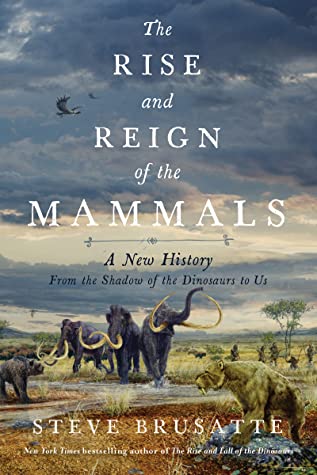A fascinating book about how mammals rose and dominate the large animal world
5 stars
A fascinating book about mammals, starting with their origins in the Carboniferous, alongside the group that would become the dinosaurs, then following their development through the various ages before becoming the dominant large animals after the downfall of the non-avian dinosaurs. The book makes clear that mammals did not develop from dinosaurs, nor were mammals prevented from diversifying during the age of dinosaurs (some common myths). Instead, mammals may be small, but they diversified and occupied various ecological niches before the asteroid strike gave mammals the opportunity to get large. Even then, it was not a given that our kind of mammals (placentals) would dominate the Earth, as placentals shared it with other kinds of mammals before eventually dominating the Earth. The book closes with a look at the current extinction crisis being faced by mammals (and other animals).
What follows is a chapter by chapter summary.
-
Mammal Ancestors: the …
A fascinating book about mammals, starting with their origins in the Carboniferous, alongside the group that would become the dinosaurs, then following their development through the various ages before becoming the dominant large animals after the downfall of the non-avian dinosaurs. The book makes clear that mammals did not develop from dinosaurs, nor were mammals prevented from diversifying during the age of dinosaurs (some common myths). Instead, mammals may be small, but they diversified and occupied various ecological niches before the asteroid strike gave mammals the opportunity to get large. Even then, it was not a given that our kind of mammals (placentals) would dominate the Earth, as placentals shared it with other kinds of mammals before eventually dominating the Earth. The book closes with a look at the current extinction crisis being faced by mammals (and other animals).
What follows is a chapter by chapter summary.
-
Mammal Ancestors: the story of mammals starts in the Carboniferous period. Two groups of animals would develop from the early amphibians: the Diapsids (reptiles and dinosaurs) and Synapsids (mammals). As the climate became drier, they diversified in various ways. For Synapsids, their teeth would become diverse, allowing them to handle different kinds of food. The Synapsids would lead to the Therapsids, who have a more upright posture. At this time, indications that this group is becoming warm-blooded become apparent. They would also develop one mammalian feature: hair.
-
Making a Mammal: in the Permian period, the Therapsids would give rise to Cynodonts. But the Permian would end with a massive extinction event due to super volcanic eruptions. The Cynodonts would then diversify, but became smaller and nocturnal. The dinosaurs and crocodilians would, however, became larger. The Cynodonts would also become fully warm-blooded. At this time, a defining feature of mammals would develop: a new kind of hinge for the lower jawbone, which would give mammals the ability to chew.
-
Mammals and Dinosaurs: It is now the Jurassic period. Mammals have become small, and appear nondescript. But diversification among different groups of mammals still continued, and some groups of mammals would become extinct. At this time, evidence for the development of mammary glands and milk can be found. And some bones that once formed the jaw of mammals would migrate to the inner ear, allowing better hearing. This would happen many times among different lines of mammals due to the many ways of chewing food, which affects bone development.
-
The Mammalian Revolution: during the Cretaceous period, the supercontinent, Pangaea, begins to break apart into northern and southern hemispheres. Mammals could now be found everywhere in the northern continent, but were mainly rodent-like. A group of mammals called Multituberculates would evolve to feed on the new flowering plants now appearing. Another mammals ground, the Therian mammals, would come up specialized molar teeth to handle insects now showing up to pollinate flowers. The Therians would give rise to modern day marsupial and placental mammals. The Monotreme mammals (like the platypus) would develop in the southern continents.
-
Dinosaurs Die, Mammals Survive: heading into the Palaeocene, an asteroid hits the Earth, causing large scale extinctions, especially the non-avian dinosaurs. They were too large, with specialized diets, to be able to survive. The small, generalist mammals would survive, and eventually grew bigger as Earth recovered.
-
Mammals Modernize: the Eocene period would be populated by mainly placental mammals that were now larger. They are also recognizable when compared to modern day mammals. Modern DNA analysis can now be used to generate the family tree of mammals. They showed that the first placental mammals to appear were the hoofed animals and primates, followed by the rodents and carnivores. South America would have its own host is mammals different from the northern continents, including predatory marsupials. But DNA would show that South American rodents and primates were from Africa, probably arriving via drifting vegetable rafts from Africa.
-
Extreme Mammals: mammals have now grown into various extremes, based on sizes and their habitats. In Africa, mammals ranging from elephants, manatees, and aardvarks to golden moles, would be found to be more closely related to each other via DNA studies. There were also numerous elephants, some bigger than current day ones. Bats would also master flight, but how is not clear due to a lack of fossils. In contrast, fossils of various whales have been found, showing that their ancestors were small, hoofed animals that could swim.
-
Mammals and Changing Climates: during the Oligocene and Miocene periods, other recognizable mammals like rhinos, camels, horses would appear. Grasslands would develop and spread during a cooler and dryer climate. Mammals would form various adaptations for eating grass, like having longer teeth or constantly growing teeth. During this time, the Marsupials in the southern continents would start to die out, replaced by placental animals, except in Australia.
-
Ice Age Mammals: the cooling climate would lead to various Ice Ages and ice age mammals like the mastodons and mammoths in North America. North and South America would meet during this time, leading to a major migration of species. Other megafauna like woolly rhino and sabre tooth cats could now be found.
-
Human Mammals: the story of primates would start with the first, very early primates discovered in Montana, which was a tiny tree dweller with teeth adapted for fruits and soft vegetation. Primates would spread around the world before going extinct in North America. Afterwards, primates would become reduced in numbers in the rest of the world, except Africa. It is in Africa that hominids would get their start in walking and tool making and began to spread throughout the world. Big mammal extinctions would begin, probably caused by humans and climate change. The domestication of dogs and other animals and plants would also being.

